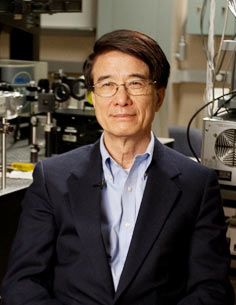C.W. "Paul" Chu
 In his physics lab at the Texas Center for Superconductivity at the University of Houston, C.W. “Paul” Chu continues to search for solutions to the world’s energy problems.
In his physics lab at the Texas Center for Superconductivity at the University of Houston, C.W. “Paul” Chu continues to search for solutions to the world’s energy problems.The superconductivity pioneer, known for his discovery with colleagues of superconductivity above 77° Kelvin (the boiling point of liquid nitrogen), is hoping to achieve superconductive properties at even higher temperatures with minimal cooling necessary. Chu, who founded TCSUH and now serves as its executive director, receives funding from the Air Force Office of Scientific Research and the Department of Energy to develop new materials.
“Whenever you are doing any cooling, you are consuming energy,” he said. “So when you can get to the point where you are operating superconducting devices without cooling them, you change every aspect of our lives, wherever electricity is involved. That will induce an industrial revolution. It is very exciting.”
A superconductor is a unique material that loses its resistance to electricity when you cool it below a certain temperature. Superconducting materials are now being used to make devices for energy generation, transmission and storage, as well as ultra-fast and ultra-sensitive signal detection and magnets for magnetic resonance imaging (MRI).
“In other words, superconducting transmission cables can be used to transmit electricity over long distances without energy loss,” he said. “Today, we use copper wire or aluminum wire which is less efficient, so superconductors can do wonders.”
Chu is so passionate about superconductivity because he sees it as key to helping stave off future energy shortages by improving the efficient use of existing resources. Superconducting material also can be used in devices like fault current limiters, inserted into electrical grids to help prevent blackouts and brownouts during lighting strikes or other power surges, or for medical applications such as MRI machines, he said.
“If we can reduce the cost of the magnetic resonance imaging technology and improve its mobility, that would have a major impact on health care in the Third World,” Chu said.
For his work, Chu has been given countless prestigious awards, including the Comstock Prize, Bernd Matthias Prize, the Texas Instruments Founders Award, the Prize Ettore Majorana-Erice-Science for Peace and the National Medal of Science. He was named the Best Researcher in the U.S. in 1990 by U.S. News & World Report, and has been inducted into the National Academy of Sciences and the American Academy of Arts and Sciences, and other prestigious foreign academies.
Though the awards are nice, Chu said it is his passion for his work that keeps him going – passion he likes to share with students.
“I tell them I work seven days a week, and more than 10 to 12 hours a day,” he said. “I don’t expect a student to do the same, but I never feel that it is very hard, because that is where my heart is.”

 Show Printable Version
Show Printable Version